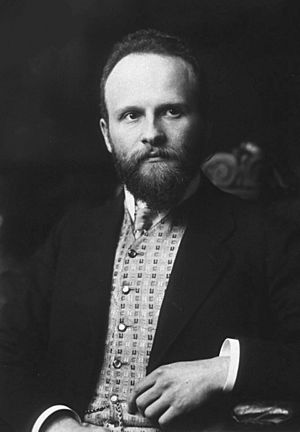Robert Bárány facts for kids
Quick facts for kids
Robert Bárány
|
|
|---|---|
 |
|
| Born | 22 April 1876 |
| Died | 8 April 1936 (aged 59) Uppsala, Sweden
|
| Nationality | Austrian in Austria-Hungary (1876–1919) Swedish (1919–1936) |
| Alma mater | University of Vienna (MD) |
| Awards | Nobel Prize in Physiology or Medicine (1914) |
| Scientific career | |
| Fields | Medicine |
| Institutions | Uppsala University |
Robert Bárány (born April 22, 1876 – died April 8, 1936) was a doctor from Austria. He specialized in studying the ear. He won the 1914 Nobel Prize in Physiology or Medicine for his important work. His research helped us understand how the inner ear helps us keep our balance.
Contents
Robert Bárány: The Balance Doctor
Robert Bárány was born in Vienna, which was part of Austria-Hungary at the time. He was the oldest of six children. His father, Ignác Bárány, worked at a bank and managed estates. His mother, Maria, was the daughter of a scientist.
Early Life and Medical Training
Robert Bárány studied medicine at the University of Vienna. He finished his medical degree in 1900. After becoming a doctor, he started working in Vienna.
How He Discovered the Inner Ear's Secrets
One day, Dr. Bárány was treating a patient who felt dizzy. He was using water to clean the patient's ear. When he used cold water, the patient felt dizzy and their eyes moved strangely. This eye movement is called nystagmus.
Dr. Bárány then tried warming the water. When he used warm water, the patient's eyes moved in the opposite direction! This made him curious. He thought that the fluid inside the inner ear, called endolymph, moved differently with hot and cold temperatures.
He believed this movement of fluid was sending signals to the brain about balance. He called this the "caloric reaction." His discoveries helped doctors understand and treat problems with the inner ear that cause dizziness. He also studied other parts of the body that help with balance, like the cerebellum.
A Nobel Prize During Wartime
During World War I, Dr. Bárány worked as a surgeon for the Austro-Hungarian Army. He was captured by the Russian army and became a prisoner of war.
In 1914, he was awarded the Nobel Prize in Physiology or Medicine. But he was still in a Russian prison camp! Thanks to efforts from countries like Sweden, Denmark, Norway, and the Netherlands, and the Red Cross, he was released in 1916.
He was then able to go to the Nobel Prize ceremony in 1916 to receive his award. After this, in 1917, he became a professor at Uppsala University Faculty of Medicine in Sweden. He worked there until he passed away.
Later Life and Legacy
Robert Bárány died in Uppsala, Sweden, just before his sixtieth birthday. His son, Ernst Bárány, also became a doctor and a member of the Royal Swedish Academy of Sciences. His grandson, Anders Bárány, is a physicist.
See also
 In Spanish: Robert Bárány para niños
In Spanish: Robert Bárány para niños
- Bárány chair
- List of Austrian scientists
- List of famous Austrians
- List of famous Hungarians
- List of Jewish Nobel laureates
- Spatial disorientation
- Instrument flight
- Instrument rating

